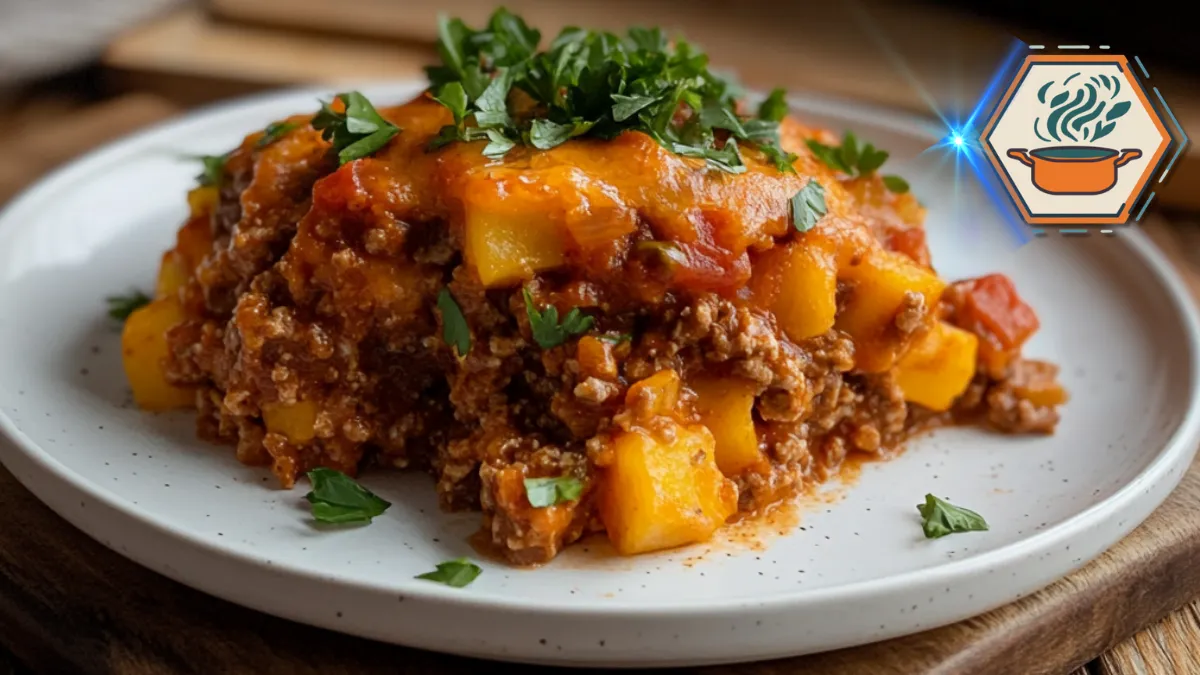Time to read:12 minutes
Table of Contents
Understanding Cowboy Casserole
Cowboy casserole is a hearty dish made with simple ingredients like ground meat, potatoes, and cheese. These cowboy casserole ingredients create a comforting meal that’s easy to prepare and loved by families everywhere. It’s versatile, flavorful, and a perfect choice for lunch or dinner. Let’s dive into the details of what makes this dish special.
What is Cowboy Casserole?
Cowboy casserole is a baked dish combining layers of meat, vegetables, and potatoes. It often includes a creamy sauce, cheese, and spices for added flavor. The recipe is straightforward, making it popular among busy home cooks.
- Why is it called Cowboy Casserole? The name reflects its rustic, filling nature, ideal for feeding a crowd or satisfying a big appetite.
- Main features: It’s rich in protein and carbohydrates, offering both energy and comfort.
For those exploring other casserole options, check out this guide to taco potato casserole, a variation that adds a Tex-Mex twist.
Origins of Cowboy Casserole
The origins of cowboy casserole are not clearly documented, but the dish likely evolved in the American Midwest. It’s inspired by traditional cowboy meals cooked over open fires, using minimal yet filling ingredients.
- Cultural roots: Cowboys relied on accessible ingredients like potatoes, canned goods, and meat.
- Evolution: Modern cowboy casserole adds a touch of convenience, using ingredients like frozen hash browns or condensed soup.
If you’re curious about similar hearty dishes, learn more about brisket sandwiches, another filling choice from American cuisine.
Popular Variations Across the U.S.
Cowboy casserole recipes vary by region, but the core concept remains the same. Here are some notable styles:
- Classic Cowboy Casserole
- Made with tater tots as the top layer.
- Includes cream of mushroom or chicken soup for a creamy texture.
- Tex-Mex Style
- Adds black beans, salsa, and jalapeños.
- Features Mexican cheese blends for extra zest.
- Vegetarian Cowboy Casserole
- Replaces meat with lentils or black beans.
- Incorporates fresh vegetables like zucchini or bell peppers.
- Breakfast Cowboy Casserole
- Combines eggs, sausage, and hash browns.
- Perfect for a morning crowd.
Key Ingredients Found in Most Recipes
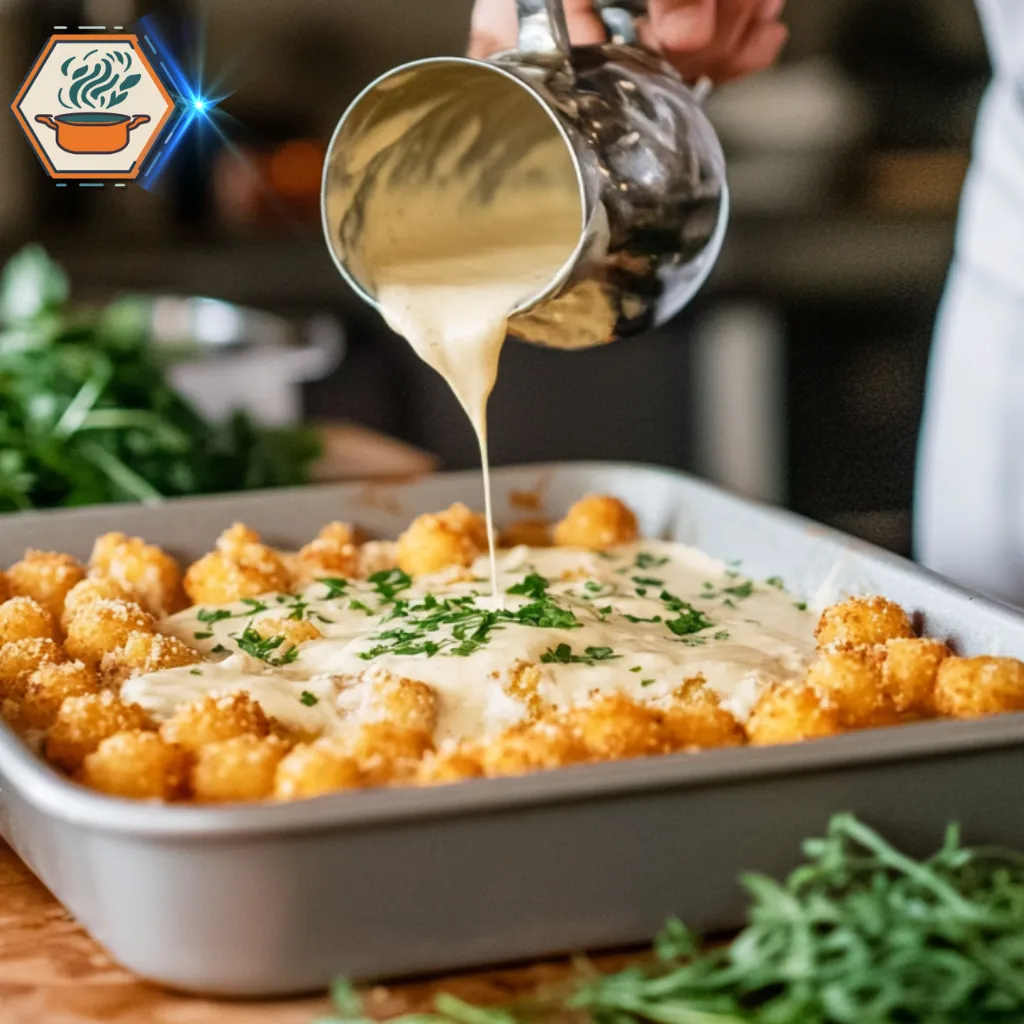
The success of a cowboy casserole lies in its ingredients. Here are the essentials:
1. Protein (Ground Meat or Alternatives)
- Most recipes use ground beef, but turkey or chicken work too.
- Vegetarian options include lentils or textured vegetable protein.
2. Potatoes
- Hash browns or sliced potatoes form the base or topping.
- Some variations use tater tots for crunch and flavor.
3. Vegetables
- Common choices include onions, corn, and green beans.
- Frozen vegetables work well for convenience.
4. Sauce
- Cream soups (e.g., mushroom, chicken) are staples.
- Homemade béchamel sauce can add a gourmet touch.
5. Cheese
- Cheddar is the most popular choice.
- Monterey Jack or mozzarella can be used for a different flavor.
Tip: Fresh ingredients improve flavor and nutrition. Learn how to keep pancakes crispy for more cooking tips that apply to versatile recipes like cowboy casserole.
6. Seasonings
The secret to a perfect cowboy casserole lies in selecting the right cowboy casserole ingredients. These staples ensure every bite is hearty, flavorful, and comforting. Understanding these components will help you create a dish that’s not only satisfying but also versatile enough to suit various tastes and occasions.
1. Protein (Ground Meat or Alternatives)
Protein forms the hearty foundation of your cowboy casserole. Ground beef is the most traditional option, prized for its rich and savory flavor. For a leaner alternative, ground turkey or chicken works just as well while keeping the dish lighter. Vegetarians can also enjoy cowboy casserole by substituting ground meat with plant-based options like lentils or textured vegetable protein. Whichever option you choose, seasoning the protein properly is essential to bring out its flavor and complement the other cowboy casserole ingredients.
2. Potatoes for the Perfect Texture
Potatoes are a cornerstone ingredient in cowboy casserole, offering a starchy base and a comforting texture. Hash browns, sliced potatoes, or the ever-popular tater tots are common choices. They not only add a satisfying crunch or creaminess but also soak up the rich flavors of the dish. For a healthier twist, you can experiment with sweet potatoes or cauliflower as substitutes while still maintaining the essence of classic cowboy casserole.
3. Vegetables for Flavor and Nutrition
Vegetables are an essential part of cowboy casserole ingredients, providing both flavor and nutrients. Classic options like onions, corn, and green beans bring a natural sweetness and crunch to the dish. Fresh vegetables elevate the casserole’s taste, but frozen options work just as well for convenience. Adding bell peppers, zucchini, or even diced tomatoes can enhance the flavor profile, making the dish even more colorful and nutrient-rich.
4. Creamy Sauces to Bind the Ingredients
A creamy, flavorful sauce ties all the cowboy casserole ingredients together. Cream of mushroom or cream of chicken soup is a staple in most recipes, offering richness and depth. For a gourmet touch, try making a homemade béchamel sauce or a cheese-based sauce. Dairy-free alternatives like cashew cream or coconut milk can be used for those with dietary restrictions, ensuring that everyone can enjoy a delicious cowboy casserole.
5. Cheese for a Gooey, Golden Finish
No cowboy casserole is complete without a generous layer of cheese. Shredded cheddar is the classic choice, providing a gooey, golden finish that elevates the dish. For a twist, you can use Monterey Jack, Pepper Jack, or even mozzarella to bring a different flavor and texture to your casserole. A sprinkle of Parmesan on top adds a hint of sharpness and creates a beautifully crispy topping.
6. Seasonings to Bring It All Together
Seasoning is the secret weapon that turns simple cowboy casserole ingredients into an irresistible dish. Basics like salt, pepper, and garlic powder are must-haves, but you can also add paprika, chili powder, or Italian seasoning for a more robust flavor. Fresh herbs like parsley or cilantro add a burst of freshness, while a pinch of cayenne pepper can provide a subtle heat for those who love a spicy kick.
For a comprehensive overview of casseroles, including their history and preparation techniques, consider exploring the University of Illinois Extension’s guide on Casseroles. This resource provides detailed insights into the origins of casseroles and offers practical tips for creating them.
This dish has earned its place in American kitchens for being both easy to prepare and endlessly customizable. It’s a true staple for casual family meals or potluck gatherings.
Ingredients in Cowboy Casserole
Cowboy casserole is a hearty dish made with simple ingredients that combine for a rich, comforting meal. To create the perfect casserole, understanding the right combination of cowboy casserole ingredients is essential. Let’s dive into the key elements that make this dish delicious.
Base Ingredients: Potatoes, Ground Meat, and Vegetables
The foundation of a cowboy casserole lies in its base ingredients. Each element plays a critical role in providing flavor, texture, and substance to the dish.
1. Potatoes
- Potatoes act as the starchy base, offering a satisfying texture.
- Russet or Yukon Gold potatoes work best because of their fluffiness and ability to absorb flavors.
- Alternative options: For a low-carb version, consider using sweet potatoes or cauliflower.
2. Ground Meat
- Ground beef is the most traditional choice. Its richness adds depth to the casserole.
- Turkey or chicken can be used for a leaner option.
- Ensure the meat is seasoned and browned before layering it into the casserole to enhance the overall taste.
3. Vegetables
- Classic vegetables include:
- Corn
- Green beans
- Diced onions
- These add natural sweetness and crunch.
- Frozen or fresh vegetables can be used, but fresh often delivers better flavor and texture.
For a comprehensive comparison between fresh and frozen vegetables, consider exploring the U.S. Department of Agriculture’s (USDA) resource on How to Save More on Fruits and Vegetables. This guide provides valuable insights into the nutritional differences, cost considerations, and practical uses of both fresh and frozen produce, aiding you in making informed choices for your recipes.
Sauces and Seasonings for Flavor
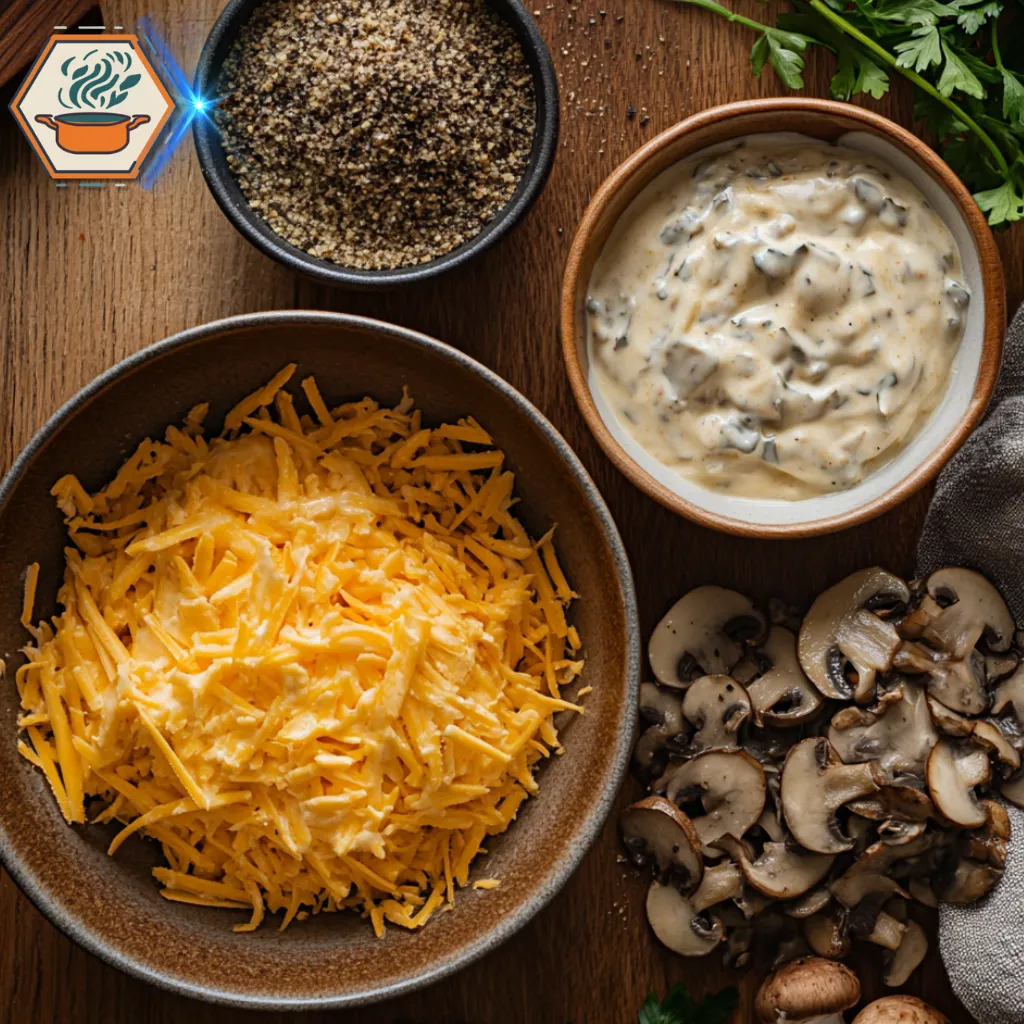
The sauces and seasonings are what transform basic ingredients into a cohesive and flavorful dish.
1. Creamy Sauces
- Cream of mushroom or cream of chicken soup is often used to bind the ingredients together.
- For a dairy-free alternative, try coconut cream or cashew-based sauces.
2. Tomato-Based Additions
- Some variations include a tomato layer, such as diced tomatoes or tomato paste, for added tanginess.
- Mixing in a bit of barbecue sauce can give the dish a smoky kick.
3. Seasonings
- The right seasonings elevate the flavor:
- Garlic powder
- Onion powder
- Paprika
- Black pepper
- Always taste as you go to avoid over-seasoning.
4. Cheese
- Shredded cheddar is a popular choice, creating a gooey and rich topping.
- For a unique twist, consider Monterey Jack or a sharp white cheddar.
Tip:
Adding a sprinkle of parsley or cilantro just before serving brightens the flavors and adds a pop of color.
Optional Additions for a Gourmet Touch
If you want to take your cowboy casserole to the next level, consider adding these gourmet touches:
1. Bacon Crumbles
- Crispy bacon bits sprinkled on top add a savory crunch.
2. Peppers
- Bell peppers or jalapeños introduce a spicy or sweet element.
3. Sour Cream or Greek Yogurt
- A dollop on top provides creaminess and a tangy contrast.
4. Breadcrumb Topping
- Combine breadcrumbs with melted butter and Parmesan cheese to create a golden, crispy crust.
Choosing Fresh and Quality Ingredients
The quality of your ingredients directly impacts the taste and texture of the dish. Follow these tips for selecting the best components:
- Potatoes: Look for firm, smooth potatoes without blemishes or sprouts.
- Ground Meat: Choose fresh, high-quality meat with a rich red color and minimal fat content.
- Vegetables: Opt for fresh, vibrant vegetables. If using frozen, avoid those with freezer burn.
- Cheese: Grate your own cheese rather than using pre-shredded for a creamier melt.
By selecting fresh and high-quality ingredients, your cowboy casserole will have a depth of flavor that stands out.
How to Make Cowboy Casserole
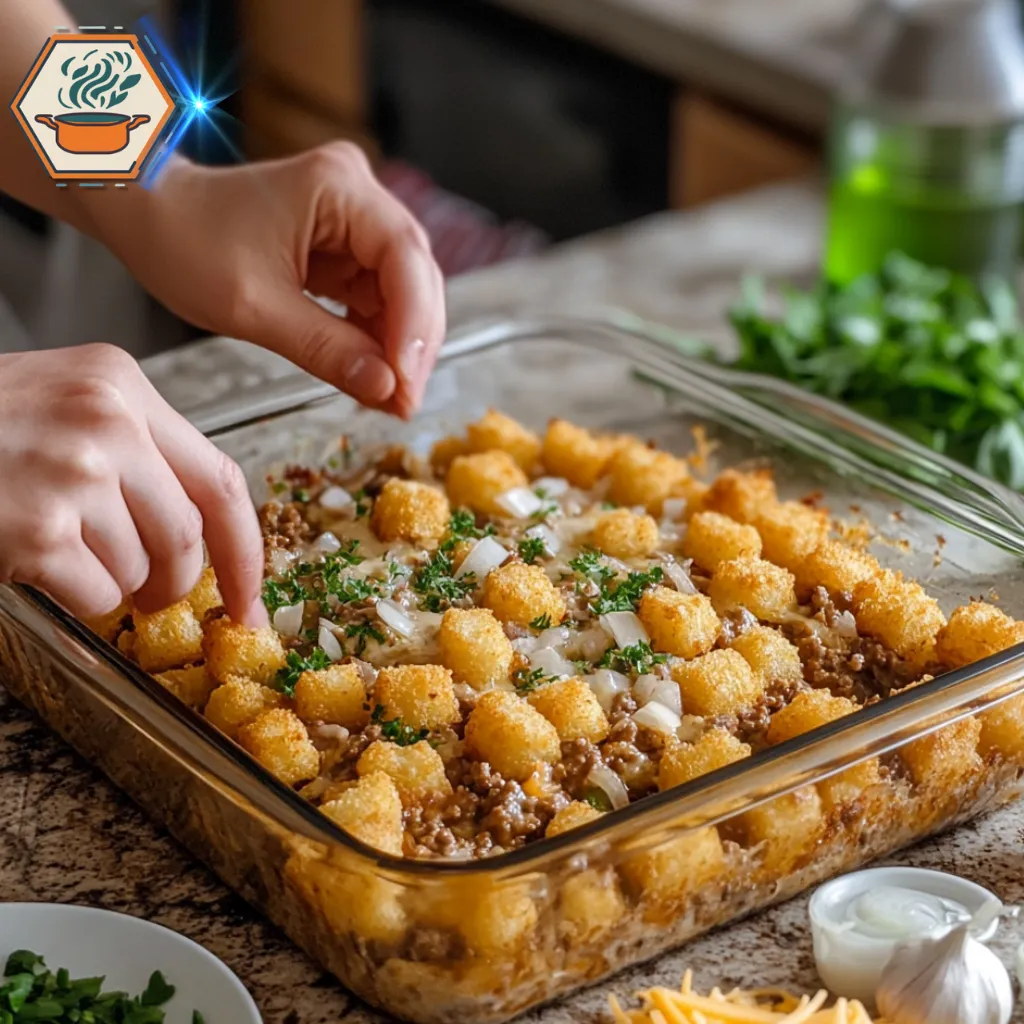
Cowboy casserole is a hearty and flavorful dish that combines comforting ingredients to create a meal the whole family will enjoy. This guide will help you prepare the dish with ease and ensure it turns out delicious every time. The main cowboy casserole ingredients typically include ground beef, tater tots, and a creamy sauce, but there are plenty of ways to customize it to your taste.
Step-by-Step Cooking Guide
Follow these steps to make your cowboy casserole:
- Prepare the Ingredients:
- Gather your main cowboy casserole ingredients, including:
- 1 lb ground beef
- 1 medium onion, diced
- 1 can of cream of mushroom soup
- 1/2 cup sour cream
- 1 cup shredded cheddar cheese
- 1 bag of frozen tater tots
- Salt, pepper, and optional seasonings like paprika or garlic powder.
- Gather your main cowboy casserole ingredients, including:
- Cook the Ground Beef:
- Heat a large skillet over medium heat.
- Add the ground beef and diced onion, breaking up the beef as it cooks.
- Cook until the beef is browned and fully cooked. Drain excess grease.
- Season the beef with salt, pepper, and any additional spices you prefer.
- Mix the Sauce:
- In a medium bowl, combine the cream of mushroom soup and sour cream.
- Stir well until the mixture is smooth and creamy.
- Optionally, add a splash of milk if the sauce seems too thick.
- Layer the Casserole:
- Preheat your oven to 375°F (190°C).
- In a greased 9×13-inch baking dish, evenly spread the cooked ground beef mixture across the bottom.
- Pour the prepared sauce mixture over the beef layer, ensuring it’s evenly distributed.
- Sprinkle half of the shredded cheddar cheese over the sauce for a flavorful middle layer.
- Arrange the frozen tater tots on top in a single, even layer to create the crispy topping.
- Bake:
- Place the casserole in the preheated oven.
- Bake uncovered for 25-30 minutes or until the tater tots are golden brown and crispy.
- Remove from the oven and sprinkle the remaining cheese over the top. Return to the oven for an additional 5 minutes or until the cheese melts.
- Serve and Enjoy:
- Allow the casserole to rest for 5 minutes before serving to let the layers set.
- For a finishing touch, garnish with chopped green onions or fresh parsley if desired.
Baking Tips for Perfect Results
- Use Fresh Ingredients: High-quality beef and fresh dairy products enhance the overall flavor.
- Crisp Tater Tots: For extra crispy tater tots, consider baking them on a separate tray for a few minutes before layering them on the casserole.
- Cheese Variations: Swap cheddar cheese for a blend of Monterey Jack, Colby, or even Pepper Jack for a spicy kick.
- Even Cooking: Ensure your casserole is baked evenly by rotating the dish halfway through the cooking time.
Common Mistakes and How to Avoid Them
- Overcrowding the Pan: Avoid overcrowding the skillet when cooking the ground beef, as this can lead to steaming rather than browning.
- Uneven Layers: Spread each layer evenly to ensure consistent flavors in every bite.
- Skipping the Seasoning: Season the ground beef well to prevent a bland base.
- Burning the Cheese: Add the final cheese layer at the end to prevent it from burning during baking.
Quick Substitutions for Missing Ingredients
If you don’t have all the cowboy casserole ingredients, here are some quick substitutions:
- Ground Beef: Use ground turkey, chicken, or plant-based meat for a healthier or vegetarian option.
- Cream of Mushroom Soup: Substitute with cream of chicken soup or make a homemade version by blending sautéed mushrooms with a roux and milk.
- Tater Tots: Replace with mashed potatoes, diced potatoes, or sweet potato cubes for a unique twist.
- Sour Cream: Use Greek yogurt or mayonnaise for a similar creamy texture.
- Cheddar Cheese: Any melting cheese, such as mozzarella or Gouda, works well.
Tobiko Storage and Buying Tips
Tobiko fish roe is a versatile and flavorful ingredient in Japanese cuisine. To enjoy it fully, you need to know how to store it, identify quality, and find the best buying options. Let’s dive into these essential tips to ensure your tobiko experience is always top-notch.
Quick Comparison: Tobiko vs. Masago
| Feature | Tobiko | Masago |
|---|---|---|
| Size | Larger | Smaller |
| Texture | Crunchy | Softer |
| Price | Moderately priced | More affordable |
How to Store Tobiko for Freshness
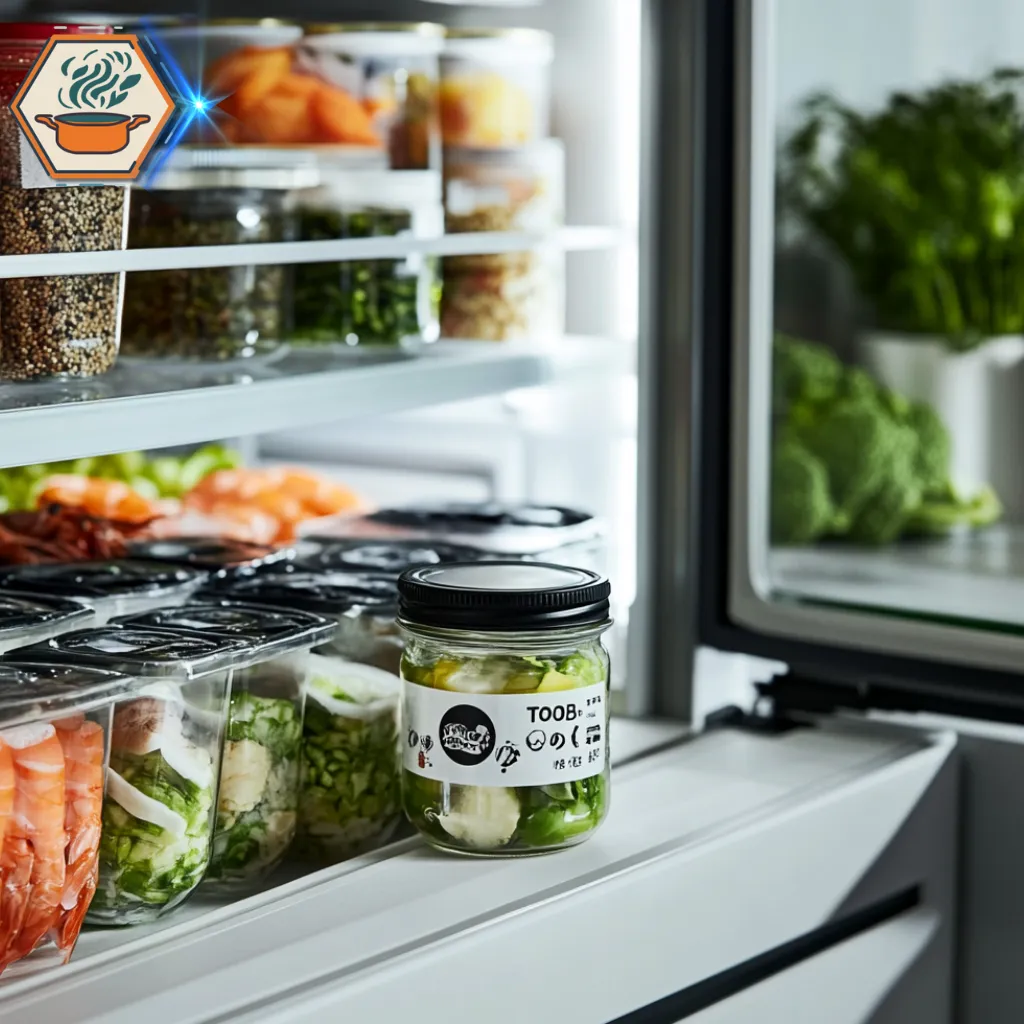
Proper storage of tobiko fish roe is key to maintaining its taste and texture. Tobiko is perishable, so following these guidelines will help:
- Refrigerate Immediately: Keep tobiko refrigerated at 32°F to 39°F (0°C to 4°C). Always store it in an airtight container to prevent exposure to air and odors from other foods.
- Freeze for Longevity: If you’re not using tobiko within a week, freezing is an excellent option. Wrap it tightly in plastic wrap or vacuum-seal it, then place it in a freezer-safe bag or container. This helps preserve its flavor for up to three months.
- Defrosting Tips: When ready to use, defrost tobiko slowly in the refrigerator overnight. Avoid thawing at room temperature to prevent spoilage.
Quick Checklist for Tobiko Storage
- Use airtight containers
- Refrigerate promptly
- Freeze if storing for over a week
- Defrost in the fridge only
Learn more about the Bone Broth Cooking and Storage Guide to pair tobiko with warm broths in unique recipes.
How to Identify Quality Tobiko
Choosing high-quality tobiko fish roe ensures a better culinary experience. Follow these tips to identify the best tobiko:
- Color Consistency: Fresh tobiko has vibrant colors such as orange, red, black, or green, depending on flavor additions. The color should look natural and not overly artificial.
- Texture: Tobiko should feel firm and slightly crunchy. Avoid overly mushy or dry textures, which can indicate poor handling.
- Smell: Fresh tobiko has a mild, briny aroma. If it has an overly fishy or unpleasant odor, it’s likely not fresh and should be avoided.
- Packaging: When buying pre-packaged tobiko, ensure the container is sealed and shows no signs of damage. Look for products labeled with clear expiration dates.
Red Flags for Low-Quality Tobiko
- Discolored or uneven hues
- Strong, off-putting odors
- Excessive liquid in the packaging
- Expired or missing date labels
Best Places to Buy Tobiko
Finding reliable sources for tobiko can make all the difference. Here are some top places to purchase:
- Japanese Grocery Stores: Specialty Asian markets often have a wide selection of tobiko in various flavors.
- Online Retailers: Trusted online platforms offer fresh tobiko delivered directly to your door. Ensure the seller uses proper refrigeration and shipping methods.
- Seafood Markets: Local seafood vendors often carry high-quality tobiko. They can also provide insights on freshness and sourcing.
Tips for Buying Tobiko Online
- Check customer reviews
- Verify refrigeration methods during shipping
- Look for sellers with high ratings for freshness
Tobiko Alternatives for Cooking
If tobiko isn’t available, there are several alternatives to consider. These substitutes replicate its unique qualities in different ways:
- Masago (Capelin Roe): Smaller and less crunchy than tobiko but offers a similar mild taste. It’s often more affordable and widely available.
- Ikura (Salmon Roe): Larger and juicier than tobiko, with a stronger flavor. Ideal for bold dishes.
- Caviar: Premium-quality caviar can serve as an upscale alternative, though it’s less briny and more buttery in taste.

